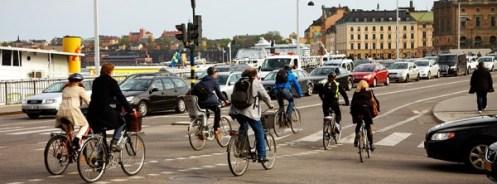We share the space – bicyclists and motor vehicles interacting; challenges and solutions – open and free webinar
What do we know and what research challenges do we need to address? Welcome to find out with SAFER and Cykelcentrum!
Cykelcentrum (Swedish Cycling Research Centre) and SAFER (Vehicle and Traffic Safety Centre at Chalmers) invite you to a webinar to share knowledge about the latest research on cyclists interacting with vehicles.
We will present four research areas where we share results and discuss common challenges ahead, as well as address thoughts on solutions.
An expert panel with representatives from the vehicle industry – Peter Kronberg, Safety Director at Volvo Group, and Johanna Smedberg, Marketing Manager at Cycleurope – will give their reflections, for example suggestions for further research questions, possible solutions, and answer your questions. During the webinar, we also give a short presentation of our centers and what opportunities we can offer for collaboration and funding of research projects. The goals of the activity are to present state-of-the art in research, discuss common challenges ahead, and inspire each other by bringing in new perspectives that can add value.
Welcome to register in the link below!
AGENDA
09.30 - INTRODUCTION
We start the webinar with short presentations of our research centres by Magnus Granström, Director, SAFER, and Jones Karlström, Deputy Director, Cykelcentrum.
Magnus Granström and Magnus Larsson, Industry Relations at Cykelcentrum, will moderate the following discussions.
After each presentation, the expert panel from industry - Peter Kronberg, Safety Director at Volvo Group, and Johanna Smedberg, Marketing Manager at Cycleurope - will ask questions, followed by time for questions from the audience.
09.45-10.15 SHARING DIFFERENT WORLDS – AN ATTENTION PERSPECTIVE ON DIFFERENT ROAD USER TYPES
Katja Kircher, Senior Research Leader in road user attention at VTI.
Even though bicyclists and motorised vehicles often use the same space, they are faced with different attentional requirements and preconditions. Results from several projects show that this is related both to how the bicycle infrastructure is designed and how bicyclists are positioned in mixed traffic. Can we learn something from these findings when planning for new infrastructure, and where do we need more research?
10.15-10.45 MICA2: MODELLING INTERACTION BETWEEN CYCLISTS AND AUTOMOBILE
Prof. Marco Dozza, Head of Crash Analysis and Prevention, Chalmers University
The MICA project modeled driver behavior in the approaching phase of an overtaking maneuver, where a driver approached a cyclist from behind with oncoming traffic present. The model predicts the probability for drivers to brake or steer as they approach the cyclists to perform an accelerative or flying maneuver respectively. The aim of the now ongoing project, MICA2, is to address the safety of the whole overtaking manoeuvre by developing and testing novel active and passive safety systems. Key findings from MICA1 and the progress in MICA2 will be presented.
10.45-10.55 BREAK
10.55-11.25 SAFER CYCLING: FROM CRASH AVOIDANCE TO INJURY REDUCTION - INCREASED VISIBILITY AND
REDUCTION OF INJURIES BY SMART CLOTHES AND MATERIALS
Associate Prof. Helena Stigson, Folksam
This project will push the development towards a reduction of injuries and at the same time aid a more sustainable mode of transport by making cycling safer. One target is to better understand how the ability of drivers to detect cyclists in conditions can increase by using smart materials and technology. Furthermore, knowledge about how shoulder protection could be developed will also be created.
11.25-11.55 VEHICLE DYNAMICS OF BICYCLES, THE WHY AND A POSSIBLE HOW
Fredrik Bruzelius, Docent in vehicle dynamics at VTI and Chalmers University
In this talk, I will introduce the topic of vehicle dynamics and how this can be applied to bicycles. Furthermore, it will be argued that the topic can be used to address and analyze issues connected to traffic safety and accessibility. Finally, a tool developed to study vehicle and rider dynamics is discussed; the VTI bicycle simulator.
11.55-12.00 CONCLUSION

